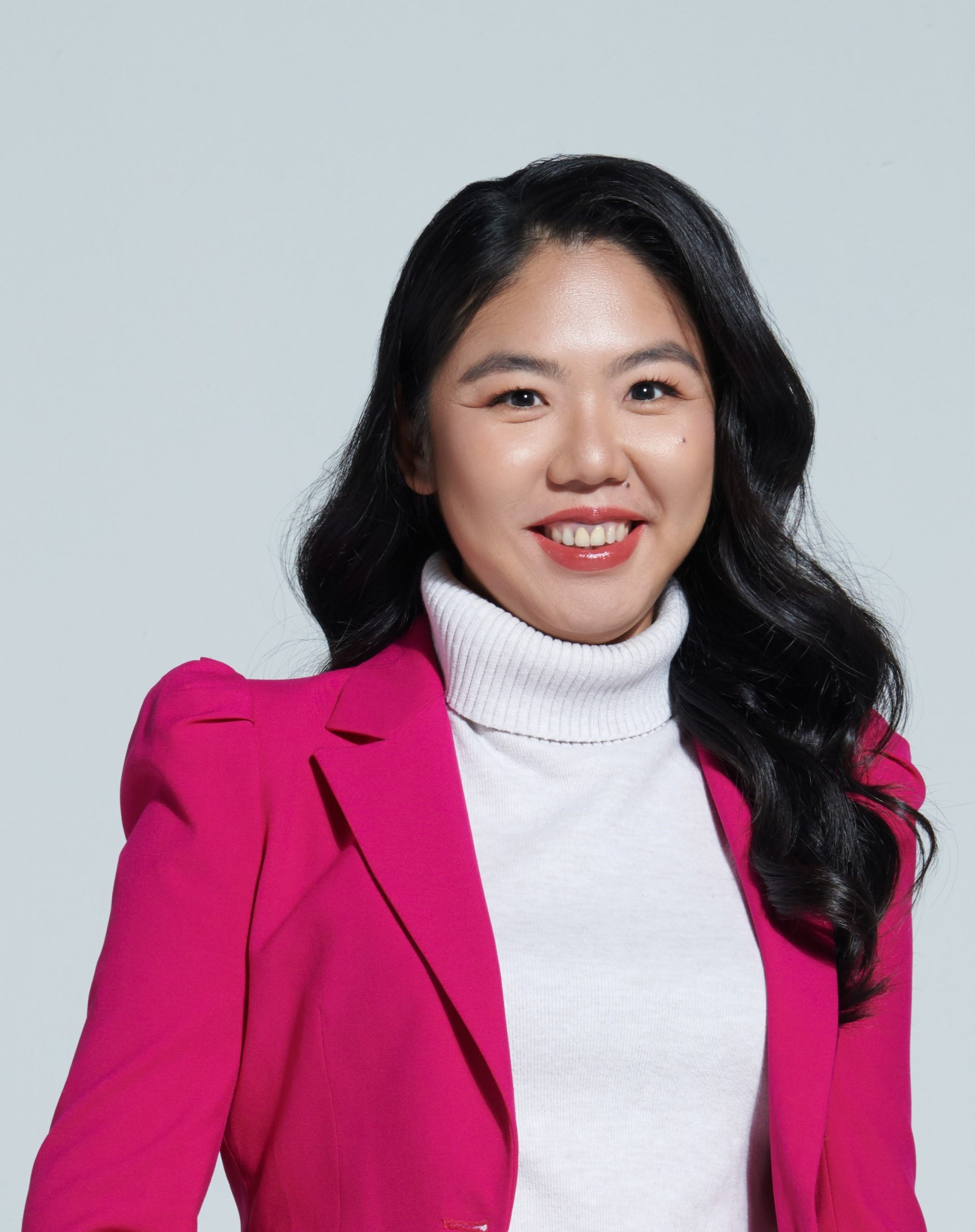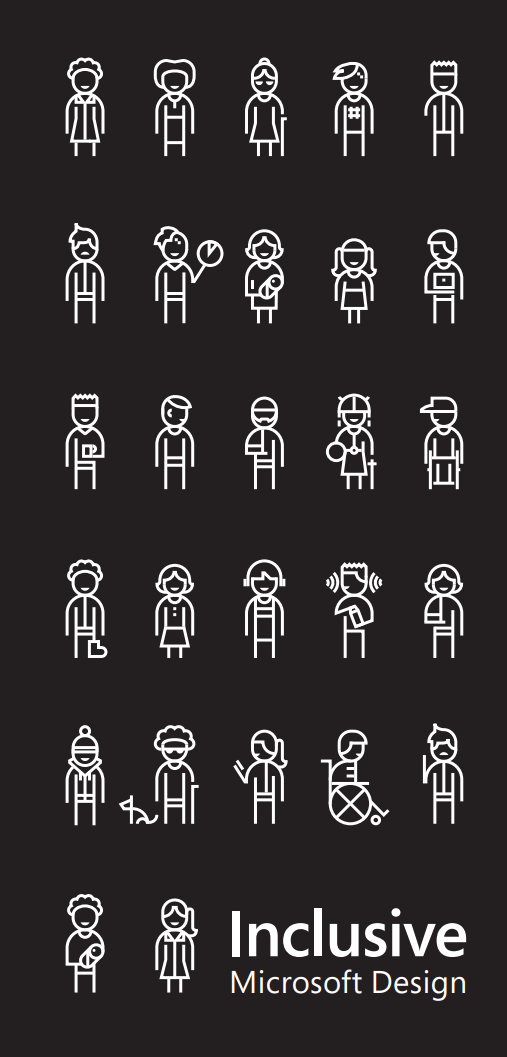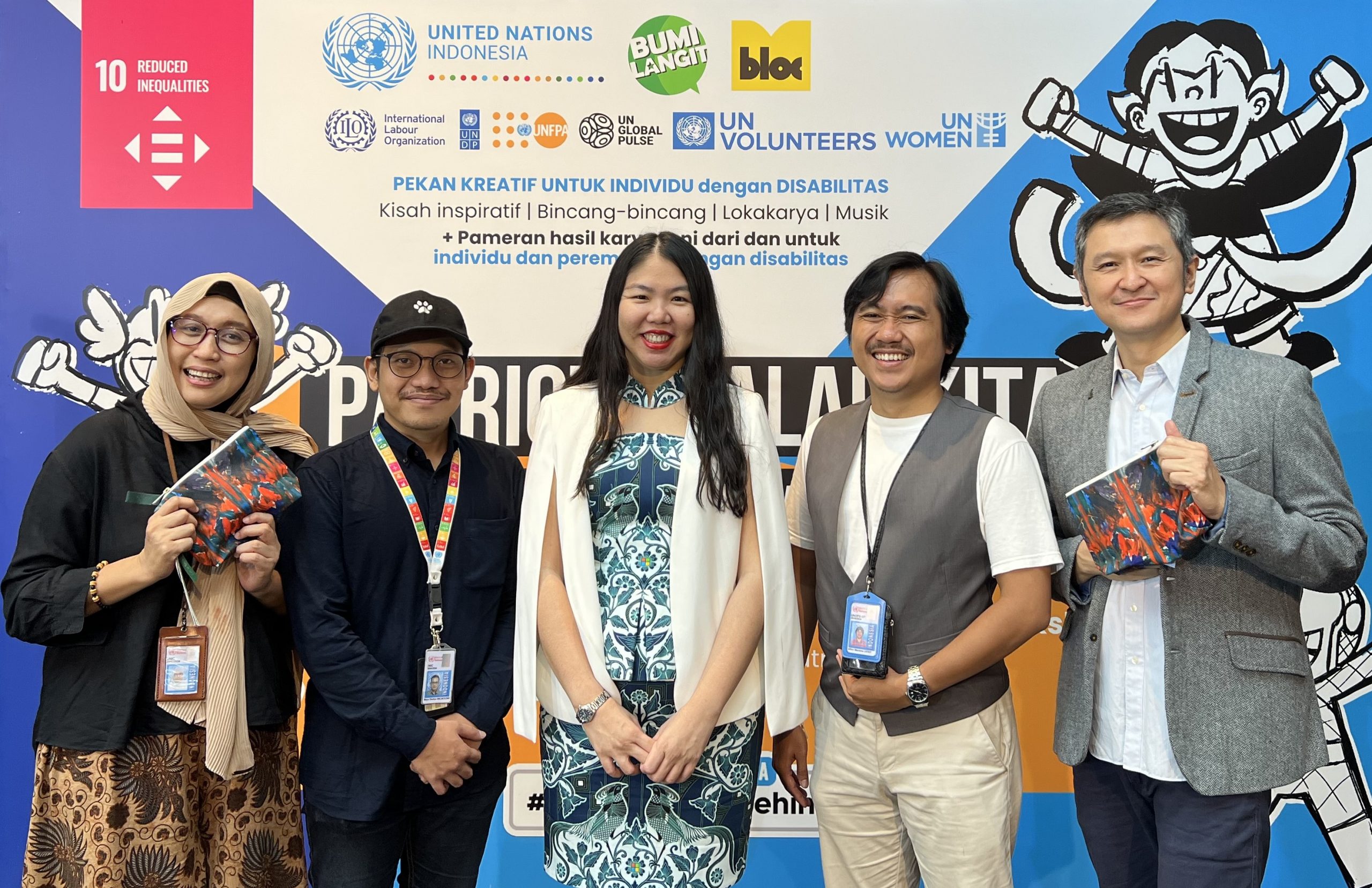(L-R) Siska Widyawati, National Information Officer United Nations Information Center Jakarta; Bayu Dwityo Wicaksono, Social Media Assistant United Nations Information Center Jakarta; Juliana Cen, Senior Partner Development Manager Microsoft Indonesia and Accessibility Lead Microsoft ASEAN; Alfian Maulana Latief, Multimedia Associate United Nations Global Pulse Asia Pacific; Agung Rachmawan, VP Licensing & Merchandising Bumilangit Entertainment
Jakarta, 8 December 2023 – In conjunction with the International Day of Persons with Disabilities commemorated every year on December 3, the United Nations in Indonesia together with Bumilangit held a Creative Week for People with Disabilities on 6-10 December 2023 at Bloc Bar 2 (exfoya) MBloc Jakarta, an endeavor supported by Microsoft. Under the motto “We are able! We are capable! We are equal!”, the event spotlights the extraordinary talents and stories of people with disabilities through art exhibitions, talkshows, and workshops. The event echoes the theme of the International Day of Persons with Disabilities, “United in action to rescue and achieve the SDGs for, with, and by persons with disabilities” to reflect the urgency of accelerating inclusive efforts toward the 2030 Agenda for Sustainable Development.
According to Valerie Julliand, the Resident Coordinator of the United Nations in Indonesia, despite the people with disabilities’ remarkable contributions in diverse fields such as art, culture, technology, and sports, the broader society often underestimates the potential of people with disabilities. “This initiative will challenge misperceptions by showcasing the profound abilities and achievements of artists with disabilities,” she said. “Through compelling stories, art, and innovative solutions, this collaboration honors these artists and urges society to reassess biases and work towards a future of inclusion and empowerment.”
There is a pressing need to realize an inclusive future. “About 80% of young people with disabilities are not involved in employment, education, or training, according to International Labour Organization (ILO). Disability can affect anyone, regardless of age, gender, ethnicity, or social status, highlighting the need for inclusion,” said Bismarka Kurniawan, CEO of Bumilangit Entertainment, one of the largest superhero comic book character libraries in Asia.
Among the keynote speakers at the event was Juliana Cen, Senior Partner Development Manager at Microsoft Indonesia. Juliana shared her personal experiences and spoke at length about how technology can be part of our journey towards inclusivity, especially for people with disabilities.
Meet Juliana Cen, a passionate advocate for the rights of people with disabilities

Juliana’s story is one of courage, resilience, and empowerment. Her exposure to the realm of neurodivergence began when her twin sons – who were toddlers at the time – were diagnosed with autism spectrum disorder (ASD). In navigating the challenges of being a mom of two kids with disabilities, she was initially hesitant to share her story, but then Juliana found support from Microsoft’s Employee Resource Group where all Microsoft neurodiverse employees gather, share stories, and give recommendations.
As time went on, Juliana began to notice that the symptoms that her sons showed that led to their diagnosis were also present in her childhood. “My mom thought that the symptoms we see in my sons were common because I had those symptoms when I was little. Aside from that, as I began to study further about autism, I found several characteristics and thought processes associated with it [autism] that are very similar to my own. So, I took several online tests, and the results were always the same — borderline personality; or in other words a borderline between neurodivergent and neurotypical, with a tendency towards neurodivergence. The tests suggested I meet a local psychologist. Therefore, I went to consult with experts. That’s when I got clinically diagnosed with Asperger’s,” Juliana recalled.
The diagnosis gave her closure — it helped her understand why she thinks and behaves differently than most people. “But it also comes with a question; do I disclose this to my colleagues like I did about my sons? I feared what people would think of me, I’m scared of not being accepted, and once the news goes out to the public, I wonder if people would only see me as someone with Asperger’s,” said Juliana.
“Through the same community I met in Microsoft, I learned that there are other people who got diagnosed as neurodivergent in adulthood too, and they use all platforms they can think of to boost awareness and acceptance of autism. That gives me the courage to openly share my condition with my family and friends, and eventually with my colleagues and the public at large. So, on World Autism Awareness Day 2023, I revealed my condition in a video – initially only meant for Microsoft colleagues internally – and published it on my social media with the hope of increasing autism awareness and acceptance,” Juliana explained.
Creating Inclusive Technology for Neurodiverse Community
Neurodivergent individuals are those who have neurological differences that affect their learning, thinking, and behavior. These differences result in unique strengths and abilities — some may have high levels of concentration and be able to master complex subjects or skills, some others may be fair and impartial in their judgment hence treating everyone equally and respectfully, and yet some others may have exceptional abilities in certain areas such as mathematics, science, art, and language. All of them may have witnessed the rise of technology, but have they truly benefited from it?
Technology is often considered as an enabler to unlock new opportunities. In a similar vein, technology has the potential to help neurodivergent and people with other disabilities at large, to hone these special abilities, enhance their independence, and access opportunities that might otherwise be inaccessible. “Accessibility fosters inclusivity by leveraging digital innovations and harnessing insightful data, enabling more informed decision making and positively impacting lives,” acknowledged Faizal Thamrin, Data Innovation Lead, UN Global Pulse Asia Pacific.
Technology can also empower people with disabilities to contribute to society and the economy and showcase their talents and skills. “Our lives are highly intertwined with technology that rapidly evolves. So, if we truly do not want to leave anyone behind, we have to create a world that meets diverse needs thus creating an environment where people of various abilities are welcomed. Because imagine how confusing and scary it is to live in a world designed without you in mind,” Juliana added.

To envision that environment, according to Juliana, technology must first and foremost be inclusive, and this has Microsoft written all over it. Microsoft is committed to advancing technology in ways that are driven by ethical principles that put people first, and this is also shown from one of the company’s AI breakthroughs, which is Microsoft Copilot. However, Microsoft is not stopping there. In order to create an inclusive, accessible, and user-friendly technology, three important principles must be adhered to:
- Recognize exclusion. Acknowledge that we have biases, and that disability is created when there’s a mismatched interaction between a person and their environment. As designers, it’s our responsibility to know if our design excludes certain groups.
- Learn from diversity. Inclusive design means putting people at the center from the very start of the process. So, involve PWD to acquire fresh, diverse perspectives every step of the way.
- Solve for one, extend to many. Did you know that high-contrast screen settings were initially made to help people with vision impairments? Today, many people benefit from high-contrast settings when using a device in bright sunlight. It’s just one example of how a design for one condition might work well for different people in similar circumstances.
As a company, added Juliana who is an Accessibility Lead for Microsoft ASEAN, Microsoft also prioritizes the principle of inclusivity in all aspects, encouraging empathy and allyship to empower every individual and organization on this planet to achieve more. This commitment is brought to life, for example, by:

- Applying inclusive design in all of its technologies, including Windows 11, Microsoft 365, Microsoft Teams, and Visual Studio. Microsoft’s Inclusive Design methodology is also shared publicly to help people understand how they can integrate inclusive design into their work.
- Partnering with organizations such as the National Disability Committee, Difalink, and PT Panasonic Gobel Life Solutions Sales Indonesia to expand the reach of Microsoft Enabler, an initiative that brings together non-profit organizations, employer partners, and people with disabilities in Asia Pacific–including Indonesia–to create an inclusive work environment where everyone can show their potential at work.
- Empowering people with disabilities to harness the power of AI and solve the world’s pressing issues through:
- Innovation and AI for Accessibility Grants for organizations that use AI to improve the well-being and independence of people with disabilities.
- Constant innovations like Seeing AI App, a free application designed to help visually impaired people navigate their day by turning the visual world into an audible experience through the power of AI.
- Employment opportunities. Microsoft believes that people of all abilities can strengthen a workforce with innovative thinking and creative solutions, and this includes neurodivergent individuals. Therefore, for the past few years, Microsoft has had a Neurodiversity Hiring Program as part of the company’s Global Diversity and Inclusion initiative. The Indonesian office is on track to adopt this program. In 2023, four people with autism interned at Microsoft Indonesia, and the company plans to expand the reach. To ensure readiness, all employees and managers are trained to identify the different ways in which they can collaborate and support fellow neurodiverse colleagues.
Juliana is pleased to see the progress that has been made and hopes to contribute to a world that #LeaveNoOneBehind. “I used to avoid writing long emails because what’s going on in my head is more complex than what I can type. It takes a lot of time, and it is frustrating. But with tools like Bing Chat and Microsoft Copilot, I can simply put my talking points and the tools will create a proper writing or document draft to which I can make edits as needed. There are other accessibility tools that I found helpful too, and there are still so many ways technology can benefit the neurodiverse community. The key is to see the world from their perspective. For all people with disabilities, always remember that when there is no door for us, let’s build our own doors,” Juliana Cen concluded.
###

